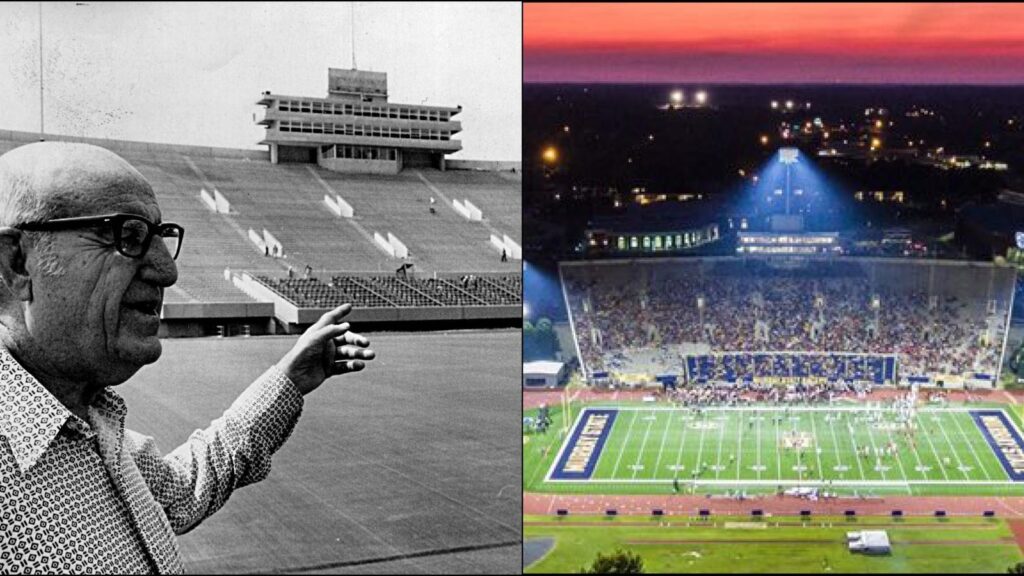 99 season.
99 season.
Visit Racers Podcast Central to find both podcasts, as well as the Racer Report LIVE podcast kicking off Racers' 100 week.Number The season opener is at Missouri (Aug. 29) and will be the first game for Murray State head coach Jody Wright. Racers Podcast Central can be found wherever you find podcasts, especially on GoRacers.com, iTunes and Spotify.
After breaking ground in 1969, the Racers were ready to play a football game at their new home, Roy Stewart Stadium, on September 15, 1973, with a crowd of 12,000 in attendance.
One thing is for sure, it wasn't an easy win for the Racers, coming against the ninth-ranked team in the country, the Western Carolina Catmounts.
According to the official stat sheet, Western Carolina won the coin toss and elected to have the ball first, but they fumbled the ball inside their own five-yard line and it was recovered by Murray State's Dan Helfitch.
The story of MSU's first touchdown began moments later when quarterback Tom Pandolfi scored a touchdown.
“Weston Carolina fumbled the ball at the 1-yard line and our coach had me take the handoff,” running back Don Clayton recalled. “It was supposed to be a dive play for me, but Pandolfi decided to do a quarterback sneak. He was smiling the whole time he did it! He always reminded me of it, even years later! We had fun with it. I felt bad for a second at the time, but then I thought, 'Oh, we won the game.' It was our stadium from the get-go, and I couldn't even smell the grass, but other than that everything was perfect.”
For the Racers, who had never previously played on anything other than natural grass, the new artificial turf at Roy Stewart Stadium marks a leap into the game's future. The artificial surface of 2024 will be much less hard on elbows and knees, as players learned firsthand in the early '70s.
“We had to wear pads on our elbows and knees because of the difference between the natural grass and the new grass,” Michigan State offensive lineman Mark Lacy said. “We got a lot of turf burns.”
Marty Strauss, who played tight end there, remembers the Racers going 6-0 in games decided by five points or less during his first two seasons.
“It was awesome. It was awesome to win some games at the very end,” Strauss said. “I'd never been in front of a crowd like that before.”
Rob Stanfa's memory of the season opener is different because he was a freshman and didn't even wear a uniform for the game.
“I was the first in my family to go to college and had never been to college, let alone watched a college football game,” Stanfa said. “It was amazing. I felt like I was in the NFL. I don't know what that meant at the time, but I was just happy to be there. I didn't know what I was going to encounter that night. There are so many emotions entangled in that first game for me, it's hard to explain it all.”
The Racers led 15-13 at halftime on a 31-yard field goal by Don Wright, likely the first Canadian player on the Racers football team.
The Racers twice reclaimed the lead, with the deciding factor being Pandolfi's 56-yard pass to Bill Farrell with 7:49 left in the game to give the Racers the winning touchdown and ultimately win the game 27-25.
The Racers and Catamounts were tied at 360 total yards each at the end of the game. MSU's Tom Johnson intercepted the Racers' first pass, recording MSU's first interception midway through the second quarter. Hall of Famer Clayton rushed 20 times for 111 yards and Pandolfi completed 16 of 23 passes for 220 yards. Scotty Crump caught seven of Pandolfi's passes for 70 yards to lead the Racers.
History shows the Racers were ready to play at the palace as Ferguson had hoped.
On the day construction began on the stadium in 1969, Ferguson said he was overwhelmed to finally be able to see the construction of Racer football's new home.
“A lot of blood, sweat and tears have gone into this,” Ferguson said. “We thought we were going to lose a lot of times. Our football people are going to do everything in their power to prove they deserve this facility.”
After beating the Cat Mounts, the Racers closed out September with wins over Tennessee Tech, 18-17, and Morehead State, 30-16. MSU beat Eastern Kentucky, 21-20, on Homecoming Day and Austin Peay, 31-19, in early November. In 1974, the Racers again went undefeated in six home games. After beating Cameron, 35-27, in the opening game, they beat UT Martin, 14-6, in early October. The month ended with wins over Middle Tennessee, 14-12, and East Tennessee, 17-3. MSU beat Eastern Illinois, 13-0, and Western Kentucky, 13-0, for an 11th straight win.
The Racers faced the same Western Carolina team in the opening game of 1975, riding an 11-game winning streak. In a closely fought game, the Racers' home winning streak came to an end with a 16-9 loss to the Catamounts.
When the Racers decided to move on from Carlisle Cutchin Stadium, which served the team well for 38 seasons (1934-72), naming the stadium after Roy Stewart was a no-brainer. Stewart, a member of Murray State's athletics department from 1932-67, was head football coach for 12 seasons and director of athletics the other years. His 60 wins were Murray State's best record, matching that of head coach Bill Ferguson.
Stewart was one of the founders of the Ohio Valley Conference in 1948. He was inducted into the Murray State University Hall of Fame in 1971 and the OVC Hall of Fame in 1977.
Stay up to date on Murray State Athletics by following the Racers on Twitter (@MSURacers), Instagram (@RacersAthletics) and Facebook. Follow Murray State Football on Twitter and Instagram (@RacersFootball).

